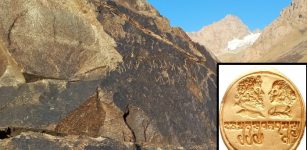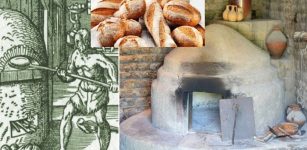Ur-Nammu – Popular And Accomplished Ruler Of Sumer
A.Sutherland - AncientPages.com – Ur-Nammu was a Sumerian king who reigned about 2112-2095 BC and was a founder of the Third Dynasty of Ur.
Initially, he held the position of Sagina - general manager or military - in the city of Ur on behalf of the king of Uruk, and its military activities contributed to an advantage over the Gutians, who had conquered Akkad, controlled of Sumer and the rest of Mesopotamia.
He revitalized the economy of Sumer and encouraged the pursuit of culture and art. This period is known as the Sumerian Renaissance and Ur-Nammu’s efforts were not in vain. Stela or Ur-Nammu. Credit: Public Domain
After the death of King Utu-hengal, Ur-Nammu seized power in Sumer and as an independent ruler of united several Sumerian cities, and then won a momentous victory over the forces of the enemy, driving him out of the country.
He called himself the brother of Gilgamesh and is widely remembered for his legal code, the Code of Ur-Nammu, the oldest known surviving example in the world. His laws known as the laws of Ur-Namma (or Code of Ur-Nammu ca. 2112-2095 BC) represent the first full set of written code found, and it is the oldest surviving tablet containing a law code that was written circa 2100 BC.
Ur-Nammu proved to be a good politician. He understands the current situation of his country, which was not the same as two hundred years ago when it lost its independence, conquered by the Assyrian king Sargon the Great.
Bust of King Ur-Nammu. Credit: Metropolitan Museum of Art - Right: The object on his head (image to the left) represents a basket of Earth. Image source
Ur-Nammu was also a good host, reformer of taxes and military forces, and builder of temples, roads, and canals; mud-brick stamped with the name of king Ur-Nammu was found in Nippur, Uruk, Eridu, Kish, Larsa, and the Ummah.
In fact "the Imperial city of Ur revived Sumer when King Ur-Nammu in 2112 BCE founded the Third Dynasty of Ur. He ruled almost the whole of Sumer and Akkad. The Sumerian Renaissance that occurred during the Third Dynasty of the city of Ur after the collapse of the Akkadian Empire between 2047-1750 BCE brought a cultural revival to Sumer. King Ur-Nammu made cultural advancements a goal of his administration and maintained peace so that the arts and technology could flourish..." we read in Henry Freeman's "Sumerians".
Many constructions (stepped temples – ziggurats, including the Great Ziggurat of Ur) originate from this Sumerian period. The construction of temples initiated by Ur-Nammu was not only a religious but also a political act.
By building and restoring temples of the gods, Ur-Nammu made Sumer strong because he appealed to the feelings of his people and united them with gods, making him a ruler - important and respected.
He revitalized the economy of Sumer and encouraged the pursuit of culture and art. This period is known as the Sumerian Renaissance, and Ur-Nammu’s efforts were not in vain.
His reputation among his subjects is clearly seen in stele and inscriptions. Then ruler was considered to have restored the ancient state of affairs by re-establishing Sumerian rule and reinforcing it. It was necessary because there was the growing power of the Amorite nomads in the Syrian steppe, and it was dangerous.
Ur-Nammu was killed during the battle against the Gutians, who returned and endangered the cities of Sumer in 2030 BC. Ur-Nammu led his army to meet them. According to the Sumerian poem ‘The Death of Ur-Nammu and His Descent to the Underworld’, his army scattered, fleeing the battlefield. and “his body lay tossed aside like a broken urn.”
And yet, his great dynasty survived and lasted for over 100 years. He was succeeded by his son Shulgi, after an eighteen-year reign, and Shulgi of the Third Dynasty of Ur (circa 2094-2047 BC) was also a great personality. He carried out a punitive campaign against the Gutians and he supported a policy of territorial or economic expansion. He was at war on a regular basis, clashing with Hurrian invaders, and finally, he was forced to oversee the construction of a wall to keep the Amorites out.
Written by – A. Sutherland - AncientPages.com Senior Staff Writer
Updated on July 28, 2021
Copyright © AncientPages.com All rights reserved. This material may not be published, broadcast, rewritten or redistributed in whole or part without the express written permission of AncientPages.com
Expand for referencesReferences:
H. Crawford, Sumer and the Sumerians
Kriwaczek, P. Babylon: Mesopotamia and the Birth of Civilization
More From Ancient Pages
-
 Jade Emperor – Supreme Ruler Of Heaven In Chinese Mythology
Chinese Mythology | Feb 21, 2019
Jade Emperor – Supreme Ruler Of Heaven In Chinese Mythology
Chinese Mythology | Feb 21, 2019 -
 Peaches Spread Across North America Through The Resourceful Networks Of Indigenous Communities
Archaeology | Nov 25, 2024
Peaches Spread Across North America Through The Resourceful Networks Of Indigenous Communities
Archaeology | Nov 25, 2024 -
 Intriguing Ptolemaic And Roman Treasures Unearthed In Al Bahnasa, Egypt
Archaeology | Jan 10, 2024
Intriguing Ptolemaic And Roman Treasures Unearthed In Al Bahnasa, Egypt
Archaeology | Jan 10, 2024 -
 Enigmatic Ancient ‘Unknown Kushan Script’ Deciphered By Scientists
Archaeology | Jul 13, 2023
Enigmatic Ancient ‘Unknown Kushan Script’ Deciphered By Scientists
Archaeology | Jul 13, 2023 -
 Secrets Of Namibia’s Fairy Circles Solved – Self-Organizing Plants Are The Creators – New Theory
Archaeology | Oct 21, 2022
Secrets Of Namibia’s Fairy Circles Solved – Self-Organizing Plants Are The Creators – New Theory
Archaeology | Oct 21, 2022 -
 Enigma Of The Solutrean People: Were First Americans European Stone Age People?
Ancient Mysteries | Sep 29, 2025
Enigma Of The Solutrean People: Were First Americans European Stone Age People?
Ancient Mysteries | Sep 29, 2025 -
 Arimaspians: Mysterious Mighty Warriors With One-Eye
Featured Stories | Mar 9, 2021
Arimaspians: Mysterious Mighty Warriors With One-Eye
Featured Stories | Mar 9, 2021 -
 Ancient Mystery Of The Enigmatic ‘Cat Men’ – Advanced Prehistoric Machines Or Humanoids? – Part 2
Ancient Mysteries | Jan 20, 2021
Ancient Mystery Of The Enigmatic ‘Cat Men’ – Advanced Prehistoric Machines Or Humanoids? – Part 2
Ancient Mysteries | Jan 20, 2021 -
 Extraordinary Biblical Frescos Uncovered In Domitilla Catacombs
Archaeology | Jun 3, 2017
Extraordinary Biblical Frescos Uncovered In Domitilla Catacombs
Archaeology | Jun 3, 2017 -
 Malagana Remarkable Sophisticated Goldwork: Legacy Of Colombian Pre-Hispanic Culture
Artifacts | Nov 14, 2018
Malagana Remarkable Sophisticated Goldwork: Legacy Of Colombian Pre-Hispanic Culture
Artifacts | Nov 14, 2018 -
 Incredible Anatomical Human Machines – Two Fleshless Bodies Mystery
Featured Stories | Jul 24, 2018
Incredible Anatomical Human Machines – Two Fleshless Bodies Mystery
Featured Stories | Jul 24, 2018 -
 Mysterious Teotihuacan ‘Host’ Figurines From Metepec, Mexico
Artifacts | Jan 6, 2016
Mysterious Teotihuacan ‘Host’ Figurines From Metepec, Mexico
Artifacts | Jan 6, 2016 -
 Rare 3,300-Year-Old Sword Accidentally Discovered In Jesenicko, Czech Republic
Archaeology | Nov 9, 2020
Rare 3,300-Year-Old Sword Accidentally Discovered In Jesenicko, Czech Republic
Archaeology | Nov 9, 2020 -
 First Carbon-Based Paleolithic Paintings Found In Font-De-Gaume Cave, France Could Be 19,000 Years Old
Archaeology | Dec 29, 2023
First Carbon-Based Paleolithic Paintings Found In Font-De-Gaume Cave, France Could Be 19,000 Years Old
Archaeology | Dec 29, 2023 -
 Mysterious Philistines: They Migrated Across Mediterranean – DNA Testing Shows
Archaeology | Jul 4, 2019
Mysterious Philistines: They Migrated Across Mediterranean – DNA Testing Shows
Archaeology | Jul 4, 2019 -
 A Remarkable Curse Tablet Dated To the 1st Century AD – Unearthed In Tongeren
Archaeology | Jul 10, 2020
A Remarkable Curse Tablet Dated To the 1st Century AD – Unearthed In Tongeren
Archaeology | Jul 10, 2020 -
 Troublemaker Eris: Greek Deity That Ignited Hatred Among All
Featured Stories | Apr 11, 2024
Troublemaker Eris: Greek Deity That Ignited Hatred Among All
Featured Stories | Apr 11, 2024 -
 On This Day In History: Vlad II Known As Vlad Dracul (‘Vlad The Dragon’) Was Born – On August 30, 1400
News | Aug 30, 2016
On This Day In History: Vlad II Known As Vlad Dracul (‘Vlad The Dragon’) Was Born – On August 30, 1400
News | Aug 30, 2016 -
 History Of Bread: Basic Food Of Man In Ancient And Contemporary Cultures Around The World
Ancient Traditions And Customs | Jun 18, 2023
History Of Bread: Basic Food Of Man In Ancient And Contemporary Cultures Around The World
Ancient Traditions And Customs | Jun 18, 2023 -
 Riddle Of An Ancient Underground City No-One Thinks Exist – Symbol For A Spiritual Quest – Part 2
Ancient Mysteries | Sep 18, 2019
Riddle Of An Ancient Underground City No-One Thinks Exist – Symbol For A Spiritual Quest – Part 2
Ancient Mysteries | Sep 18, 2019


